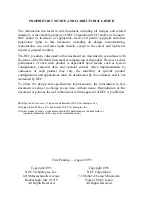
34
Step 4 “I-phase (charging voltage adjustment)”: The battery is charged with
a constant current (I-phase) until the end-of-charge voltage 14.4 V/14.8 V is
reached for a 12 V battery, or 7.2/7.6 V for a 6 V battery.
Step 5 “U1-phase (charging current adjustment)”: The battery voltage is held
constant and the charging current adapts to the level of charge in the battery.
The fuller the battery, the lower the charging current.
Step 6 “Test”: The test draws a defined load current from the battery. If the
voltage of the loaded battery falls back to its rated voltage, this indicates a high
internal resistance or a high level of sulphation.
Step 7 “Trickle charging phase”: If the battery is left connected to the charger, a
trickle charge is performed cyclically. This step is performed a varying number of
times, depending on the battery voltage and charging mode.
8.2 | Charging process
When you connect the charger to the power supply (220-240 V/AC 50/60 Hz),
the LCD display lights up. If the voltage is above 7.8 V, the charger recognises the
battery as a 12 V battery – if the voltage is below 7.8 V, the charger recognises it
as a 6 V battery. If the battery is incorrectly connected, the
symbol lights up.
The device will switch into Recovery mode if the voltage is in the range from
7.8 V to 10.5 V or 3.9 V to 5 V respectively. A pulsating 0.8 A current is fed to the
battery until the voltage reaches 10.5 V or 5.25 V respectively.
If the battery voltage does not reach 10.5 V or 5.25 V respectively within
30 minutes, an error is displayed. The charger switches off and the
– +
symbol
lights up.
If the voltmeter continues to flash and jump back and forth after 60 minutes of
charging, a normal charging process has not been started but the
– +
symbol
does not light up, this also means that the battery is defective. In this case,
charging must be aborted manually.
When charging begins, the charger checks whether the battery is deeply
discharged. If the battery is deeply discharged, the charger starts a recovery or
desulphation process, in which the battery is fed with a pulsating current. Then
normal charging is resumed.
Normal charging means that the battery is first charged with a constant current
(I-phase) until the end-of-charge voltage of 14.4 V or 7.2 V is reached. The voltage
is then held constant (U1 phase) and the charging current adapts to the level of
charge in the battery. The fuller the battery, the lower the charging current. If the
charging current falls below about 0.2 A, the charging process is ended and the
charger switches automatically into Test mode. If the voltage drops to below
12 V or 6 V after a minute, the battery is recognised as “faulty”. The charger then
switches itself off and the
– +
symbol lights up.
Once the battery has been charged, all the bars in the charge level indicator are
lit permanently. This means that the battery is charged and ready for use, and
Содержание 60901901
Страница 41: ...41 ...









































